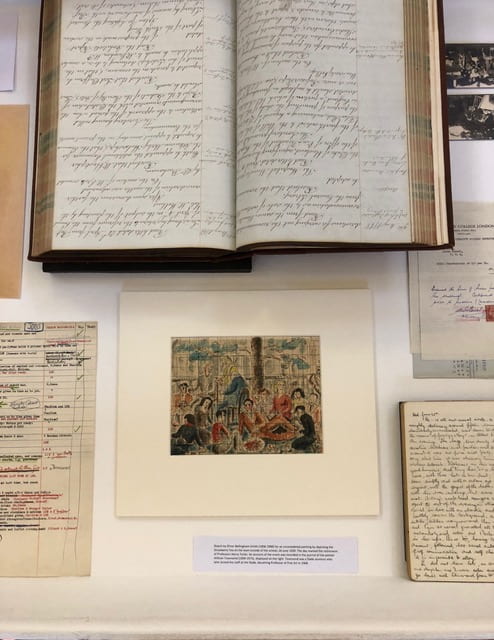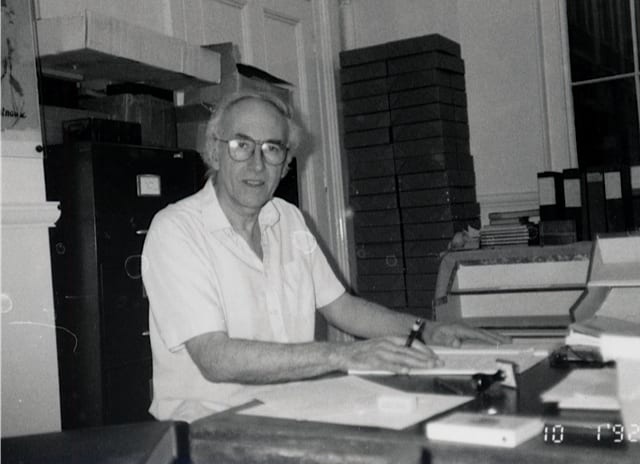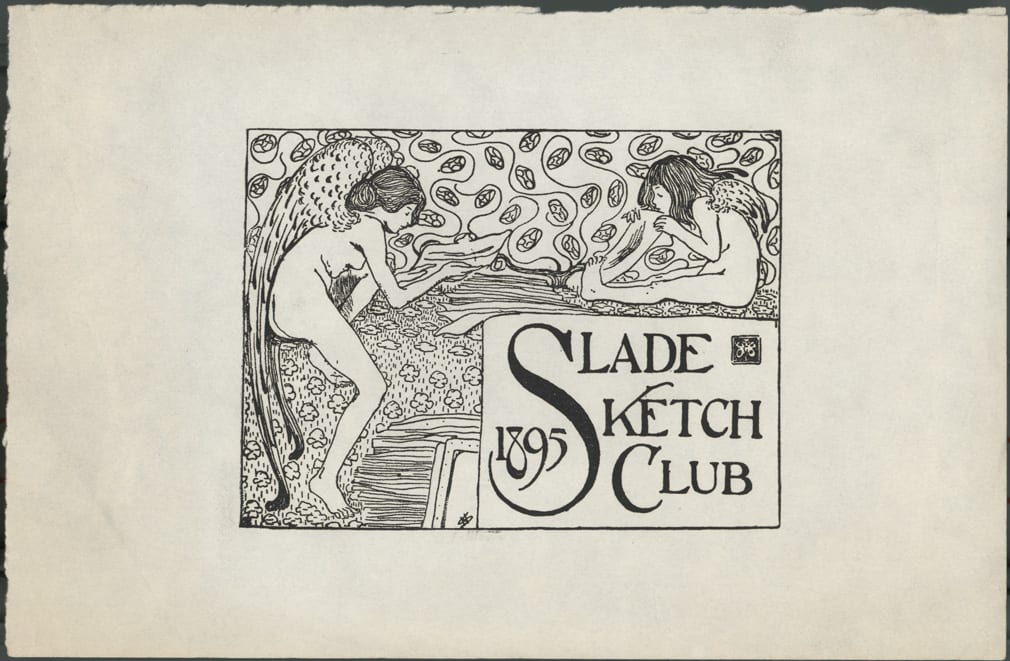Slade Archive Project Phase II
By Slade Archive Project, on 20 April 2020
 It may seem that things have been quiet with the Slade Archive Project – even more so now, given the current Covid-19 crisis – but we have been busy working on a number of exciting developments and will continue to do so working remotely in the coming weeks.
It may seem that things have been quiet with the Slade Archive Project – even more so now, given the current Covid-19 crisis – but we have been busy working on a number of exciting developments and will continue to do so working remotely in the coming weeks.
Last year we embarked on a new phase of the project which looks towards the school’s 150th anniversary in 2021. After reflecting on the various activities undertaken in Phase I, we have developed a number of aims for Phase II. We are approaching this milestone as a chance not only to celebrate the Slade and its alumni, but also to:
- enhance and challenge known histories of the school and its legacies, through both internal and external research, and with a particular focus on transnational scholarship and international knowledge exchange
- continue to develop, showcase and improve access to Slade archive collections, in part through digital technologies
- promote cross-disciplinary engagement with the Slade’s archive collections, including, but not limited to, those emerging through fine art practice
- use the Slade’s 150th anniversary as a springboard to explore different approaches to engaging with institutional histories
- continue to pilot different ways to use, enhance, create and disseminate archival resources
- foster collaboration across different disciplinary boundaries and through internal and external partnerships
- integrate teaching and learning opportunities, public programming and outreach activities with research activities
- and disseminate our findings through open access platforms.
Current areas of activity are:
- Transnational Slade (Phase II), in collaboration with the ‘Slade, London, Asia’ Research Group, part of ‘London, Asia’ research project led by the Paul Mellon Centre, which includes a current pilot activity with ResearchSpace, British Museum
- Slade Film Department (1960-1984), ‘Materiality, Archives and the Slade at the Nexus of Art School Filmmaking’ (working title) research project led by Brighid Lowe and Henry Miller
- The curation and cataloguing of Slade archive collections, in collaboration with UCL Library Special Collections and UCL Department of Information Studies
- William Townsend Journals digital project (with UCL Library Special Collections)
- Slade Photo collection cataloguing project (with UCL Library Special Collections)
- Tracing artistic heritages through the architectural fabric of the Slade
Vital cataloguing and conservation activities underpin these activities and research aims. The wonderful team at UCL Library Special Collections have been hard at work reappraising and upgrading the catalogue records for the Slade archive collection. This is an ongoing, collaborative effort to make what is an eclectic and disparate collection of records more accessible for researchers. We are grateful for the work of the UCL Library Special Collections team – Sarah Aitchison, Katy Makin, Kathryn Meldrum, Colin Penman, Rebecca Sims, Robert Winckworth, Angela Warren-Thomas and Steve Wright – who have together undertaken this mammoth task. UCL Library Digital Collections now has a dedicated area for digitised Slade Archive materials. We hope to add more records in the months to come.
From 2015-2018, the UCL Art Museum’s ‘Spotlight on the Slade’ Project also made great headways in cataloguing Slade collections. This research project was supported by the Paul Mellon Centre for Studies in British Art, and sought to increase access to UCL Art Museum’s Slade Collections through research, cataloguing, digitisation, collaboration and public engagement. As part of this research, colleagues at the Museum discovered that approximately 45% of works in UCL Art Museum’s collection are by women artists. This is an astonishing statistic: typically, permanent collections in Europe and the US contain between 3-5% of works by women.
We have also updated guidelines for researching the Slade archive collections, and welcome additions to our growing bibliography on the topic of the Slade and its many histories.
In 2018, we marked the 150th anniversary of the death of the school’s namesake and founding father, Felix Slade (1788-1868). Slade, a lawyer and notable collector of glass, engravings, books and bindings, bequeathed endowments for the founding of three Slade Professorships of Fine Arts: at Oxford, Cambridge and University College London. Funds for a studentship were also bequeathed for UCL, and which formed the foundation to establish a new School of Fine Art for the teaching of professional artists, which opened three years later, in 1871. To coincide with this commemoration, UCL Library Special Collections digitised the Slade foundational papers which are now available online as part of UCL Library Digital Collections. As the papers reveal, a central idea behind the Slade school was its location within the university, and for much of its existence, the Slade shared its site with other UCL departments, including chemistry and physiology. Edwin Field (1804-1871), a lawyer, translated the terms of the bequest, and promoted the idea of establishing ‘a school of art in connection with a university, with a view to the collateral advantages that such an alliance could afford’.
A drinks reception was also held in Felix Slade’s honour, harking back to an earlier tradition of the annual Slade strawberry tea, with Slade staff, students, alumni and supporters congregating for berries and bubby in the UCL portico. We were lucky enough to have three descendants of Felix Slade join us, who generously shared their family stories and documentation with those wanting to know more. A small exhibition was also set up in the adjacent UCL Library Flaxman Gallery, showcasing some gems from the Slade archives.
The centre item featured here is by Elinor Bellingham-Smith (1906-1988), a preparatory sketch for an uncompleted painting depicting the Strawberry Tea on the lawn outside of the school on 26 June 1930.
This day marked the retirement of Professor Henry Tonks. An account of the event was recorded in the journal of the Bellingham-Smith’s friend and fellow Slade student, the painter William Townsend (1909-1973). His journals are in the care of UCL Special Collections.
The last official appearance of Tonks was an impressive and tragically simple piece of staging. At the end of his remarks he stood up and saying “I do not like saying goodbye, so there will be no official leave taking”, walked quietly with his jerky [?] walk to the door, leaving the long line of the staff, still in their places, whilst we clapped frenziedly, and for once, with real feeling and appreciation. Strawberry tea on the lawn. Tonks and Steer and Daniels from the National Gallery sit on chairs, at the edge of the crowd […] other visitors smiling and joking and drinking tea, and eating strawberries and cream. Tonks in his grey suit, looking a grey and tired, but not unhappy, old man.
Journal of William Townsend, 26 June, 1930. UCL Special Collections
William Townsend was also a Slade alumnus, who later joined the staff at the Slade, becoming Professor of Fine Art in 1968. This sketch was donated to the school by Townsend’s daughter, Charlotte Townsend-Gault, in 2017.
 Close
Close














